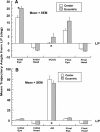Three dimensional kinematics of rapid compensatory eye movements in humans with unilateral vestibular deafferentation
- PMID: 17549461
- PMCID: PMC2104540
- DOI: 10.1007/s00221-007-0977-1
Three dimensional kinematics of rapid compensatory eye movements in humans with unilateral vestibular deafferentation
Abstract
Saccades executed with the head stationary have kinematics conforming to Listing's law (LL), confining the ocular rotational axis to Listing's plane (LP). In unilateral vestibular deafferentation (UVD), the vestibulo-ocular reflex (VOR), which does not obey LL, has at high head acceleration a slow phase that has severely reduced velocity during ipsilesional rotation, and mildly reduced velocity during contralesional rotation. Studying four subjects with chronic UVD using 3D magnetic search coils, we investigated kinematics of stereotypic rapid eye movements that supplement the impaired VOR. We defined LP with the head immobile, and expressed eye and head movements as quaternions in LP coordinates. Subjects underwent transient whole body yaw at peak acceleration 2,800 degrees /s(2) while fixating targets centered, or 20 degrees up or down prior to rotation. The VOR shifted ocular torsion out of LP. Vestibular catch-up saccades (VCUS) occurred with mean latency 90 +/- 44 ms (SD) from ipsilesional rotation onset, maintained initial non-LL torsion so that their quaternion trajectories paralleled LP, and had velocity axes changing by half of eye position. During contralesional rotation, rapid eye movements occurred at mean latency 135 +/- 36 ms that were associated with abrupt decelerations (ADs) of the horizontal slow phase correcting 3D deviations in its velocity axis, with quaternion trajectories not paralleling LP. Rapid eye movements compensating for UVD have two distinct kinematics. VCUS have velocity axis dependence on eye position consistent with LL, so are probably programmed in 2D by neural circuits subserving visual saccades. ADs have kinematics that neither conform to LL nor match the VOR axis, but appear instead programmed in 3D to correct VOR axis errors.
Figures








References
-
- Aw ST, Halmagyi GM, Haslwanter T, Curthoys IS, Yavor RA, Todd MJ. Three-dimensional vector analysis of the human vestibuloocular reflex in response to high-acceleration head rotations. II. Responses in subjects with unilateral vestibular loss and selective semicircular canal occlusion. J Neurophysiol. 1996a;76:4021–4030. - PubMed
-
- Aw ST, Haslwanter T, Halmagyi GM, Curthoys IS, Yavor RA, Todd MJ. Three-dimensional vector analysis of the human vestibuloocular reflex in response to high-acceleration head rotations. I. Responses in normal subjects. J Neurophysiol. 1996b;76:4009–4020. - PubMed
-
- Collewijn H, van der Mark F, Jansen TC. Precise recording of human eye movements. Vision Res. 1975;15:447–450. - PubMed
-
- Crane BT, Demer JL. Human gaze stabilization during natural activities: translation, rotation, magnification, and target distance effects. J Neurophysiol. 1997;78:2129–2144. - PubMed
-
- Crane BT, Demer JL. Human horizontal vestibulo-ocular reflex initiation: effects of angular acceleration, linear acceleration, stimulus intensity, target distance, and unilateral lesions. J Neurophysiol. 1998;80:1151–1166. - PubMed
Publication types
MeSH terms
Grants and funding
LinkOut - more resources
Full Text Sources

